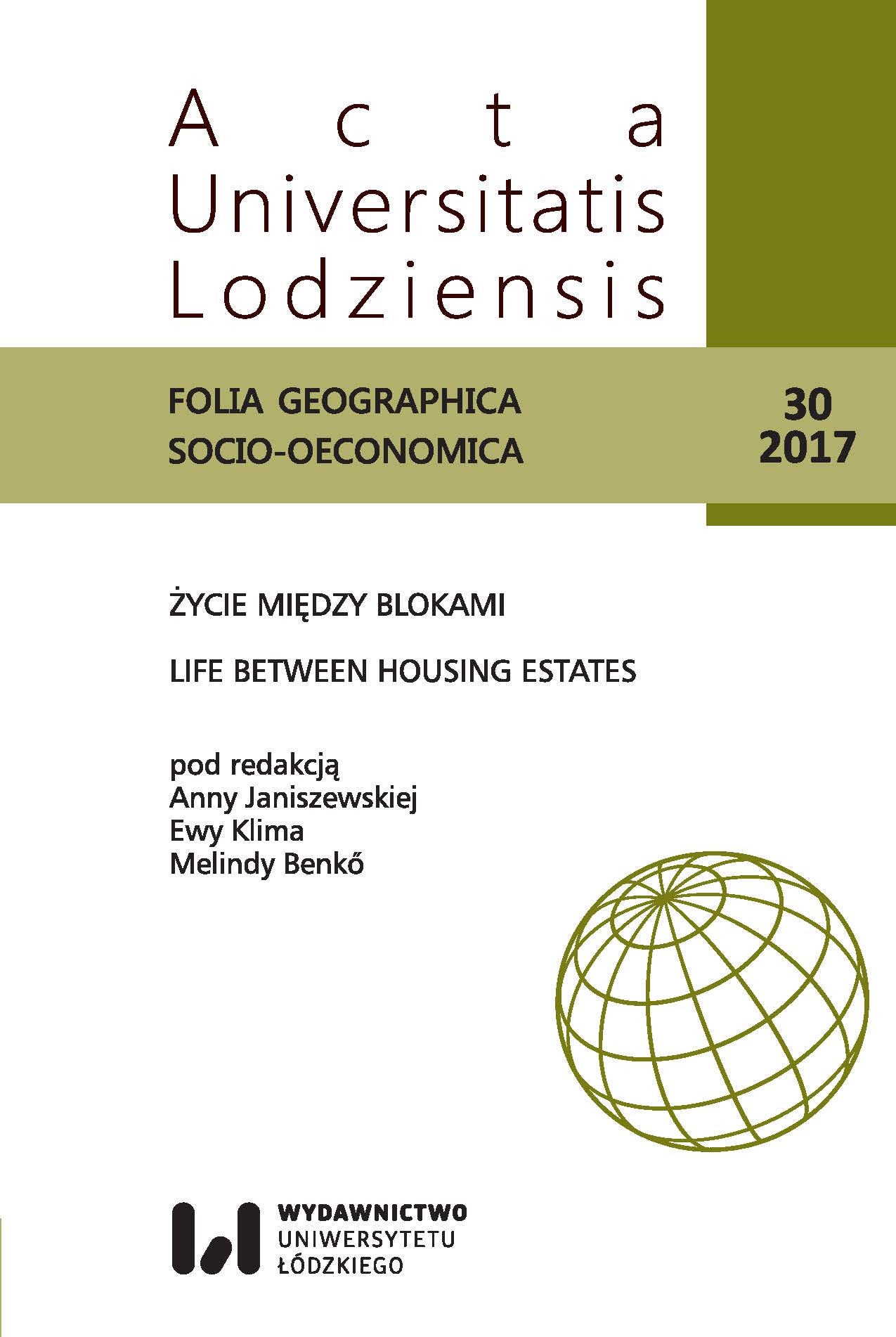Życie z psami w mieście
DOI:
https://doi.org/10.18778/1508-1117.30.05Słowa kluczowe:
przestrzeń miasta, psy, posiadacze psów, użytkowanie przestrzeni publicznych, samorządAbstrakt
Celem artykułu jest wskazanie na wybrane przestrzenne konsekwencje posiadania psów w mieście. Diagnoza obejmuje zarówno elementy przestrzeni realnej, jak i dotyczy społecznej percepcji zjawiska posiadania i życia psów w mieście. Przestrzeń została powiązana z przestrzenią publiczną, rekreacją i wypoczynkiem. Studium przypadku stanowi Łódź. Badania prowadzono od roku 2013 do 2017.
Bibliografia
Badanie budżetu czasu ludności w 2013 r., GUS, https://stat.gov.pl/files/gfx/portalinformacyjny/pl/defaultaktualnosci/5486/18/1/1/notatka_bc_2013_22_08_ost__2_.pdf.
Google Scholar
Duricek M., Obodyński K., 2006, Syntetyczne podstawy rekreacji i turystyki, Wydawnictwo Uniwersytetu Rzeszowskiego, Rzeszów.
Google Scholar
Durkheim E., 2011, Samobójstwo, Oficyna Naukowa, Warszawa.
Google Scholar
Konecki K., 2005, Ludzie i ich zwierzęta. Interakcjonistyczno-symboliczna analiza społecznego świata właścicieli zwierząt domowych, Wydawnictwo Scholar, Warszawa.
Google Scholar
Lorenz K., 2013, I tak człowiek trafił na psa, Grupa wydawnicza Foksal sp. z o.o., Warszawa.
Google Scholar
Postawy wobec zwierząt, 2003, BS/79/2013, CBOS, http://www.cbos.pl/SPISKOM.POL/2013/K_079_13.PDF
Google Scholar
Rada Osiedla Teofilów-Wielkopolska, b.d.
Google Scholar
Rozporządzenie Ministra Spraw Wewnętrznych i Administracji z dnia 26 sierpnia 1998 roku w sprawie zasad i warunków wyłapywania bezdomnych zwierząt (Dz.U., 1998, nr 116, poz. 753, z późn. zm.).
Google Scholar
Rozporządzenie Ministra Spraw Wewnętrznych i Administracji z dnia 28 kwietnia 2003 roku w sprawie wykazu psów uznawanych za agresywne (Dz.U., 2003, nr 77, poz. 687).
Google Scholar
Sławek M., Śleboda R., Bajorek W., Rzepko M., Nowak A., 2011, Przestrzeń rekreacyjna aktywności ruchowej w całorocznych zamkniętych obiektach sportowo-rekreacyjnych na podstawie wybranych jednostek osiedlowych Łodzi, „Ekonomiczne Problemy Usług”, 79: 275–301.
Google Scholar
Szacki J., 1964, Durkheim, Wydawnictwo Wiedza Powszechna, Warszawa.
Google Scholar
Szkwarek M., 2016, Miasta, które nadal pobierają opłatę za psa, Bankier.pl, https://www.bankier.pl/wiadomosc/Miasta-ktore-nadal-pobieraja-oplate-za-psa-7421102.html.
Google Scholar
Toczek-Werner S., 2007, Podstawy rekreacji i turystyki, Wydawnictwo AWF Wrocław, Wrocław.
Google Scholar
Uchwała Nr XXXI/808/16 Rady Miejskiej w Łodzi z dnia 15 czerwca 2016 roku w sprawie wprowadzenia Regulaminu utrzymania czystości i porządku na terenie miasta Łodzi (Rozdział 5 § 19.2).
Google Scholar
Uchwała nr XLIII/1154/17 Rady Miejskiej w Łodzi z dnia 15 marca 2017 roku w sprawie przyjęcia „Programu opieki nad zwierzętami bezdomnymi oraz zapobiegania bezdomności zwierząt w Łodzi na rok 2017”.
Google Scholar
Ustawa z dnia 12 stycznia 1991 roku o podatkach i opłatach lokalnych (Dz.U., 2006, 121.844).
Google Scholar
Ustawa z dnia 13 września 1996 roku o utrzymaniu czystości i porządku w gminach (Dz.U., 1996, nr 132, poz. 622).
Google Scholar
Ustawa z dnia 21 sierpnia 1997 roku o ochronie zwierząt (Dz.U., 2003, nr 106, poz. 1002, z późn. zm.).
Google Scholar
Ustawa z dnia 11 marca 2004 roku o ochronie zdrowia zwierząt oraz zwalczaniu chorób zakaźnych zwierząt (Dz.U., 2008, nr 213, poz. 1342, z późn. zm.).
Google Scholar
Verginelli F., Capelli C., Coia V., Musiani M., Falchetti M., Ottini L., Palmirotta R., Tagliacozzo A., De Grossi Mazzorin I., Mariani-Costantini R., 2005, Mitochondrial DNA from Prehistoric Canids Highlights Relationships between Dogs and South-East European Wolves, „Molecular Biology and Evolution”, 22 (12), 1 December 2005: 2541–2551, https://doi.org/10.1093/molbev/msi248.
Google Scholar
Pobrania
Opublikowane
Jak cytować
Numer
Dział
Licencja
Prawa autorskie (c) 2017 © Copyright by Authors, Łódź 2017; © Copyright for this edition by Uniwersytet Łódzki, Łódź 2017

Praca jest udostępniana na licencji Creative Commons Attribution 3.0 Unported License.








